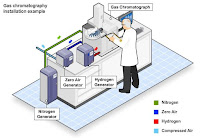The technologies that
power laptops, smartphones, LED televisions, and other technologies rely on one
hidden ingredient: Gas. Compressed and inert
gases help create a pure environment, control the temperature, and carry
other substances for a high-quality end product. See how the different gases
used play a pivotal role in technology product development and also how they
introduce health and safety risks into the workplace.
Compressed Gases Used in Technology
Devices
The most common compressed gases used in technologies
include argon (Ar), helium (He), and nitrogen (N2).
Liquid and gas helium have a range of uses in science,
laboratory, manufacturing, and technology settings. Within the semiconductor
industry, helium keeps the manufacturing environment pure so that no unwanted
chemical reactions occur. Since helium
conducts heat efficiently, it stabilizes the temperature when silicon is
introduced in the semiconductor manufacturing process. Helium's ability to cool quickly aids in a range of uses, from
chilling semiconductor wafers to keeping an MRI magnet cool.
Nitrogen (N2) gas aids with the liquidous stage of
semiconductor manufacturing, where the solder is wetting the surface to create
a good bond. Since nitrogen flushes
out oxygen, it's also used during the purging process.
Some semiconductor
manufacturing facilities have opted for nitrogen generations onsite rather than
N2 delivery from a commercial gas supplier. Since nitrogen is
one component of air, it can be distilled for purity onsite using a
generator.
Like helium (He) and nitrogen, argon or Ar is
inert. This gas is introduced in the sputtering phase of semiconductor
manufacturing. Since argon maintains a highly pure environment, it prevents
silicon crystals used in semiconductors from developing impurities.
To source these gases,
semiconductor, LED, and other manufacturers turn to compressed gas providers,
who offer on-demand delivery of combustible gases. The chief gas distributors
include Praxair, Airgas, Air Liquide, Linde, Matheson Tri-gas, and BOC.
The Hidden Dangers of Specialty Gas
While these specialty
gases are highly useful, there is a danger associated with their use. Helium, nitrogen, and argon all
deplete oxygen from the air. In the manufacturing process, this is a desired
trait. Oxygen can cause flaws in the final product.
Where trouble starts
is when leaks occur and the specialty gas escapes into a closed room.
Leaks can develop in supply lines, storage canisters, or nitrogen generators.
These gases have no scent or color, so employees would not see or smell an
argon leak.
Within minutes of a
leak, oxygen levels can fall from typical levels to deficient levels, which
means that the air in the environment does not have enough oxygen for
respiration. Employees can experience fatigue, dizziness, cognitive
confusion, and respiratory distress. A few breathe of oxygen deficient air can
render someone unconscious. Once an employee loses consciousness, the risk is
death via asphyxiation.
By tracking levels of
oxygen using an oxygen monitor, employers can prevent workplace accidents and
injuries and protect the well-being of their employees. An oxygen deficiency
monitor tracks oxygen levels 24/7 and provides fast notification if oxygen
levels plummet due to an inert gas leak.
Just as these gases
can leak in the semiconductor manufacturing plant, they can leak at the gas
distributor as well. Leaks arise when storage equipment and supply lines
develop holes, when storage dewars are not properly sealed, or when the
equipment is used in a manner for which it was not originally intended or
designed.
While end
manufacturers are well aware of the risks of an oxygen deficient environment,
there is less talk of the need for protection in gas distribution
facilities. Wherever He, Ar, and N2 are used or stored,
oxygen monitors should be installed as a precaution.
How an Oxygen Deficiency Monitor Works
An oxygen deficiency
monitor has a built-in alarm to provide LED and sound alert when oxygen
levels fall to the critical defined threshold, which is 19.5 percent.
PureAire's monitors work in confined spaces, including basements and freezers,
and function at temperatures of -40 C. PureAire's oxygen monitors are
built to withstand 10+ years of use without subjectivity to barometric pressure
shifts or temperature changes. The zirconium sensor needs no annual maintenance
or calibration.
If you're looking for
a reliable product that is easy to use out of the box, consider
PureAire's O2 monitor. Learn more about PureAire's
oxygen deficiency monitor or read customer testimonials at
https://www.pureairemonitoring.com or www.oxygenmonitors.com
Source:
http://summitsourcefunding.com/blog/helium-is-a-critical-part-electronics-supply-chain
https://www.onsitegas.com/semi-conductor-nitrogen.html













